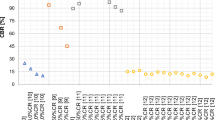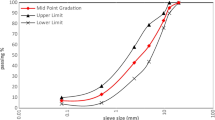Abstract
There are many issues surrounding the performance of critical assets on high-speed ballasted railway lines. At assets like switch & crossings and bridge transitions high track forces can be produced resulting in higher ballast settlements and hence track misalignments. The latter result in higher track forces and hence more settlement, leading to the need for increased track maintenance to ensure comfort and safety. Current technologies for solving issues like ballast movement under high-speed loading regimes are limited. However, a technique that has been well used across the UK and now increasingly overseas to stabilise and reinforce ballasted railway tracks is the application of in-situ polyurethane polymers, termed XiTRACK. This paper discusses how this technique can be used to solve these types of long-standing issues and presents actual polymer application profiles at two typical critical sites, namely a junction and a transition onto concrete slab-track.
Similar content being viewed by others
References
Aubry, D., Clouteau, D., Bonnet, G., 1994. Modelling of Wave Propagation Due to Fixed or Mobile Dynamic Sources. In: Chouw, N., Schmid, G. (Eds.), Wave Propagation and Reduction of Vibrations. Bochum, Germany, p.109–121.
Auersch, L., 1990. Parametric excitation of rail-wheel system: calculation of vehicle-track-subsoil-dynamics and experimental results of the high speed train intercity experimental. Ingenieur-Archiv, 60(3):141–156. [doi:10. 1007/BF00539584]
Auersch, L., 2005. The excitation of ground vibration by rail traffic: theory of vehicle-track-soil interaction and measurements on high-speed lines. Journal of Sound and Vibration, 284(1–2):103–132. [doi:10.1016/j.jsv.2004.06.017]
Auersch, L., 2006. Ground vibration due to railway traffic: the calculation of the effects of moving static loads and their experimental verification. Journal of Sound and Vibration, 293(3–5):599–610. [doi:10.1016/j.jsv.2005.08.059]
Auersch, L., 2008. The effect of critically moving loads on the vibrations of soft soils and isolated railway tracks. Journal of Sound and Vibration, 310(3):587–607. [doi:10.1016/j.jsv.2007.10.013]
Auersch, L., 2012. Train induced ground vibrations: different amplitude-speed relations for two different soils. Proceedings of the Institution of Mechanical Engineers, Part F: Journal of Rail and Rapid Transit, 226(5): 469–488. [doi:10.1177/0954409712437305]
Baeβler, M., Bronsert, J., Cuéllar, P., Rücker, W., 2012. The Stability of Ballasted Tracks Supported on Vibrating Bridge Decks, Abutments and Transition Zones. Proceedings of the 1st International Conference on Railway Technology: Research, Development and Maintenance, Civil-Comp Press, Stirlingshire, UK, Paper 13. [doi:10.4203/ccp.98.13]
Banimahd, M., 2008. Advanced Finite Element Modelling of Coupled Train-Track Systems: A Geotechnical Perspective. PhD Thesis, Heriot-Watt University, Edinburgh, UK.
Banimahd, M., Woodward, P.K., Kennedy, J., Medero, G.M., 2011. Behaviour of train-track interaction in stiffness transitions. Proceedings of the ICE-Transport, 165(3): 205–214. [doi:10.1680/tran.10.00030]
Banimahd, M., Woodward, P.K., Kennedy, J., Medero, G., 2012. Geotechnical performance of high-speed ballast railway tracks. Proceedings of the ICE-Transport, in press.
Brown, S.F., Brodrick, B.V., Thom, N.H., McDowell, G.R., 2007. The Nottingham railway test facility, UK. Proceedings of the ICE-Transport, 160(2):59–65. [doi:10.1680/tran.2007.160.2.59]
Coelho, B., Hölscher, P., Priest, J., Powrie, W., Barends, F., 2011. An assessment of transition zone performance. Proceedings of the Institution of Mechanical Engineers, Part F: Journal of Rail and Rapid Transit, 225(2): 129–139. [doi:10.1177/09544097JRRT389]
Degrande, G., Schillemans, L., 2001. Free field vibrations during the passage of a Thalys high-speed train at variable speed. Journal of Sound and Vibration, 247(1):131–144. [doi:10.1006/jsvi.2001.3718]
Dietermann, H., Metrikine, A., 1996. The equivalent stiffness of a half-space interacting with a beam. Critical velocities of a load moving along a beam. European Journal of Mechanics. A, Solids, 15(1):67–90.
Eisenmann, J., Rump, R., 1997. Ein Schotteroberban fur hohe Geschwindigkeiten. Eisenbahntechnische Rundschan, 3:99–107 (in German).
El Kacimi, A., Woodward, P.K., Lagrouche, O., Medero, G., 2012. Time domain 3D finite element modelling of train-induced vibration at high-speed. Computers & Structures, in press. [doi:10.1016/j.compstruc.2012.07.011]
Esveld, C., 2001. Modern Railway Track (2nd Ed.). MRT Productions, Zaltbommel, the Netherlands.
Galvín, P., Romero, A., Dominguez, J., 2010. Fully three-dimensional analysis of high-speed train-track-soil-structure dynamic interaction. Journal of Sound and Vibration, 329(24):5147–5163. [doi:10.1016/j.jsv.2010.06.016]
Indraratna, B., Lackenby, J., Christie, D., 2005. Effect of confining pressure on the degradation of ballast under cyclic loading. Geotechnique, 55(4):325–328. [doi:10.1680/geot.2005.55.4.325]
Kennedy, J.A., 2011. Full-Scale Laboratory Investigation into Railway Track Substructure Performance and Ballast Reinforcement. PhD Thesis, Heriot-Watt University, Edinburgh, UK.
Kennedy, J.H., Woodward, P.K., Banimahd, M., Medero, G.M., 2012. Railway track performance study using a new testing facility. Proceedings of the ICE-Geotechnical Engineering, 165(5):309–319. [doi:10.1680/geng.10.00075]
Kerr, A., Moroney, B.E., 1993. Track transition problems and remedies. Proceedings of American Railway Engineering, 94:267–298.
Krylov, V.V., 1994. On the theory of railway-induced ground vibration. Journal de Physique IV France, 4(C5):769–772. [doi:10.1051/jp4:19945167]
Lei, X., Noda, N.A., 2002. Analyses of dynamic response of vehicle and track coupling system with random irregularity of track vertical profile. Journal of Sound and Vibration, 258(1):147–165. [doi:10.1006/jsvi.2002.5107]
Lei, X., Mao, L., 2004. Dynamic response analyses of vehicle and track coupled system on track transition of conventional high speed railway. Journal of Sound and Vibration, 271(3–5):1133–1146. [doi:10.1016/S0022-460X(03)00570-4]
Li, D., Davis, D., 2005. Transition of railroad bridge approaches. Journal of Geotechnical and Geoenvironmental Engineering, 131(11):1392–1398. [doi:10.1061/(ASCE)1090-0241(2005)131:11(1392)]
Li, D., Otter, D., Carr, G., 2010. Railway bridge approaches under heavy axle load traffic: problems, causes and remedies. Proceedings of the Institution of Mechanical Engineers, Part F: Journal of Rail and Rapid Transit, 224(5):383–390. [doi:10.1243/09544097JRRT345]
Lombaert, G., Degrande, G., Kogut, J., Francois, S., 2006. The experimental validation of a numerical model for the prediction of railway induced vibrations. Journal of Sound and Vibration, 297(3–5):512–535. [doi:10.1016/j.jsv.2006.03.048]
Lundqvist, A., Dahlberg, T., 2005. Load impact on railway track due to unsupported sleepers. Proceedings of Institution of Mechanical Engineers, Part F: Journal of Rail and Rapid Transit, 219(2):67–77. [doi:10.1243/095440905X8790]
Madshus, C., Kaynia A., 2000. High speed railway lines on soft ground, dynamic behaviour at critical speed. Journal of Sound and Vibration, 231(3):689–701. [doi:10.1006/jsvi.1999.2647]
Madshus, C., Lacasse, S., Kaynia, A., Harvik, L., 2004. Geodynamic Challenges in High Speed Railways Projects. Proceedings of Geo-Trans, Los Angeles, California, GSP 126.
Paolucci, R., Maffeis, A., Scandella, L., Stupazzini, M., Vanini, M., 2003. Numerical prediction of low-frequency ground vibrations induced by high-speed trains at Ledsgard, Sweden. Soil Dynamics and Earthquake Engineering, 23(6):425–433. [doi:10.1016/S0267-7261(03)00061-7]
Pita, A.L., Teixeira, P.F., Robuste, F., 2004. High speed and track deterioration: the role of vertical stiffness of the track. Proceedings of the Institution of Mechanical Engineers, Part F: Journal of Rail and Rapid Transit, 218(1):31–40. [doi:10.1243/095440904322804411]
Takemiya, H., 2003a. Simulation of track-ground vibrations due to a high-speed train: the case of X-2000 at Ledsgard. Journal Sound and Vibration, 261(3):503–526. [doi:10.1016/S0022-460X(02)01007-6]
Takemiya, H., 2003b. Simulation of track-ground vibrations due to high speed train. Journal of Sound and Vibration, 261(3):503–526. [doi:10.1016/S0022-460X(02)01007-6]
Thompson, D.R., Woodward, P.K., 2004. Track stiffness management using the Xitrack geocomposite. Journal of the Permanent Way Institution, 122(3):135–138.
Woldringh, R.F., New, B.M, 1999. Embankment Design for High Speed Trains on Soft Soils. Proceedings of the Twelfth European Conference on Soil Mechanics and Geotechnical Engineering, Amsterdam, the Netherlands.
Woodward, P.K., Nicholl, G., Thompson, D.R., 2005. Cost effective solution of persistent track faults using XiTRACK geocomposite technology. Journal of Permanent Way Institution, 123(4):191–195.
Woodward, P.K., Kennedy, J., Medero, G., Banimahd, M., 2012a. Application of in-situ polyurethane geocomposite beams to improve the passive shoulder resistance of railway track. Proceedings of the Institution of Mechanical Engineers, Part F: Journal of Rail and Rapid Transit, 226(3):294–304. [doi:10.1177/0954409711423460]
Woodward, P.K., Kacimi, A., Laghrouche, O., Medero, G., 2012b. Breaking the ground speed barriers for ultra-speed trains: Rayleigh ground wave modelling and mitigation. International Journal of Railway Technology, 1(1): 105–119. [doi:10.4203/ijrt.1.1.5]
Woodward, P.K., Kennedy, J., Medero, G., Banimahd, M., 2012c. Maintaining absolute clearances in ballasted railway tracks using in situ 3-dimensional polyurethane GeoComposites. Proceedings of the Institution of Mechanical Engineers, Part F: Journal of Rail and Rapid Transit, 226(3):257–271. [doi:10.1177/0954409711420521]
Yang, Y.B., Hung, H.H., Chang, D.W., 2003. Train-induced wave propagation in layeredsoils using finite/infinite element simulation. Soil Dynamics Earthquake Engineering, 23(4):263–278. [doi:10.1016/S0267-7261(03) 00003-4]
Zakeri, J., Ghorbani, V., 2011. Investigation on dynamic behavior of railway track in transition zone. Journal of Mechanical Science and Technology, 25(2):287–292, [doi:10.1007/s12206-010-1202-x]
Author information
Authors and Affiliations
Corresponding author
Additional information
Project (No. EP/H027262/1) partially supported by the Engineering and Physical Sciences Research Council, UK
Rights and permissions
About this article
Cite this article
Woodward, P.K., El Kacimi, A., Laghrouche, O. et al. Application of polyurethane geocomposites to help maintain track geometry for high-speed ballasted railway tracks. J. Zhejiang Univ. Sci. A 13, 836–849 (2012). https://doi.org/10.1631/jzus.A12ISGT3
Received:
Accepted:
Published:
Issue Date:
DOI: https://doi.org/10.1631/jzus.A12ISGT3




